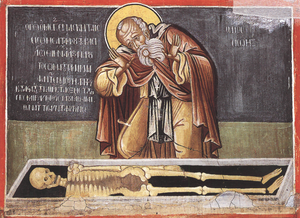Sisoes the Great
Sisoes the Great | |
|---|---|
 Saint Sisoës the Great at the tomb of Alexander the Great (16th c., Varlaam Monastery, Meteora), signifying the remembrance of death (Memento mori).[note 1] | |
| Born | 4th century Egypt |
| Died | 429 Egypt |
| Venerated in | Oriental Orthodox Churches Eastern Orthodox Church Catholic Church |
| Feast | July 6 |
Saint Sisoës the Great (also Sisoi the Great, Sisoy the Great, Sisoes of Sceté or Shishoy; Coptic: ⲁⲡⲁ ϫⲓϫⲱⲓ; †429 AD) was an early Christian desert father, a solitary monk pursuing asceticism in the Egyptian desert in a cave of his predecessor, St Anthony the Great. St Sisoës is revered as a saint by the Roman Catholic Church and the Eastern Orthodox Church, who consider him a wonderworker. His feast day is observed on July 19 [O.S. July 6].[note 2][note 3]
Sisoës was a Copt by birth. Having withdrawn the world from his youth, he retired to the desert of Sceté, and lived some time under the direction of his teacher, Abba Or. The desire of finding a retreat yet more unfrequented induced him to cross the Nile and hide himself in Mount Colzim where St. Anthony the Great had died some time before.
Text is available under the CC BY-SA 4.0 license; additional terms may apply.
Images, videos and audio are available under their respective licenses.

